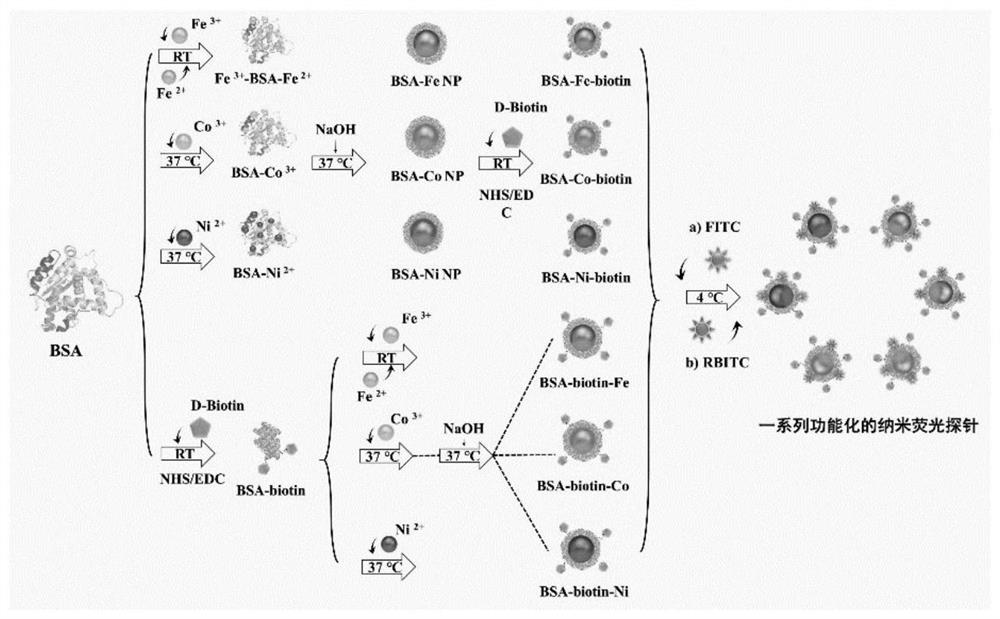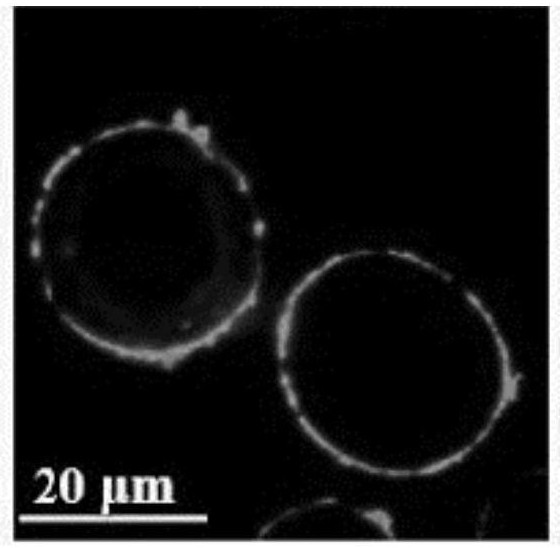Transition metal oxide nanoprobe, preparation method and application
A transition metal and nanoprobe technology, applied in the field of nanomaterials and biological analysis, can solve the problems of limited metal tag carrying capacity, lack of protein spatial distribution information, and destruction of the quantitative process.
- Summary
- Abstract
- Description
- Claims
- Application Information
AI Technical Summary
Problems solved by technology
Method used
Image
Examples
preparation example Construction
[0026] Such as Figure 5 Shown, also provide the preparation method of this transition metal oxide nanoprobe, it comprises the following steps:
[0027] (1) Dissolve a mixture of biotin, N-hydroxysuccinimide NHS and 1-ethyl-3-(3'dimethylaminopropyl) carbodiimide EDC in 2-(N-morpholine) In the ethanesulfonic acid MES buffer solution, stir vigorously at room temperature for a period of time under the condition of avoiding light to obtain the activated biotin solution; afterward, high-speed centrifugation and purification to obtain the activated biotin, and re-dissolve in DMSO to obtain the first solution;
[0028] (2) dissolving 5-50 g / L biological protein molecule solution in sodium bicarbonate buffer, and mixing to obtain the second solution;
[0029] (3) Mix the first solution and the second solution evenly, react for a period of time to obtain biotin protein, and then dialyze to obtain a purified biotin protein solution;
[0030] (4) After mixing the transition metal elem...
Embodiment 1
[0046] Preparation of iron oxide probe
[0047] A) Biotin, NHS and EDC were mixed in MES buffer solution at a molar ratio of 1:1:1, and stirred vigorously for 30 minutes at room temperature in the dark to obtain an activated biotin solution. Then centrifuge in a high-speed centrifuge at a speed of 9000 rpm for 5 minutes, discard the supernatant, and redissolve the precipitate in DMSO to obtain a reaction solution 1.
[0048] B) adding bovine serum albumin (hereinafter referred to as BSA) to a final concentration of 10 grams per liter into 0.1 moles per liter of sodium bicarbonate buffer solution with a pH of 9, which is referred to as reaction solution 2;
[0049] C) Mix the solution 1 obtained in the above step A with the solution 2 obtained in step B evenly, wherein the ratio of BSA molecules to activated biotin molecules is 1:10, react in the dark for 3 hours, and then use a dialysis bag with a molecular weight cut off of 10,000 Dialyzed for 3 days and then freeze-dried to...
Embodiment 2
[0055] Preparation of cobalt hydroxide probe
[0056] A) Add 2 ml of cobalt nitrate solution with a concentration of 50 mmol per ml to 10 ml of fibronectin solution with a concentration of 20 mg per ml, stir for 5 minutes to make it evenly mixed, then add 0.2 ml with a concentration of 2 moles per liter The sodium hydroxide solution was used to raise the final pH to above 10. After vigorous stirring for 2 hours, it was allowed to stand for 12 hours for aging, and then dialyzed for 36 hours and freeze-dried to obtain cobalt hydroxide nanoparticles mineralized by fibronectin.
[0057] B) Biotin, NHS and EDC were mixed in MES buffer solution at a molar ratio of 1:1:1.2, and vigorously stirred for 50 minutes at room temperature in the dark to obtain an activated biotin solution. Then centrifuge in a high-speed centrifuge at a speed of 7000 rpm for 5 minutes, discard the supernatant, and redissolve the pellet in DMSO.
[0058] C) the fibronectin mineralized cobalt hydroxide nanopa...
PUM
| Property | Measurement | Unit |
|---|---|---|
| Average hydrated particle size | aaaaa | aaaaa |
Abstract
Description
Claims
Application Information
 Login to View More
Login to View More - R&D
- Intellectual Property
- Life Sciences
- Materials
- Tech Scout
- Unparalleled Data Quality
- Higher Quality Content
- 60% Fewer Hallucinations
Browse by: Latest US Patents, China's latest patents, Technical Efficacy Thesaurus, Application Domain, Technology Topic, Popular Technical Reports.
© 2025 PatSnap. All rights reserved.Legal|Privacy policy|Modern Slavery Act Transparency Statement|Sitemap|About US| Contact US: help@patsnap.com



